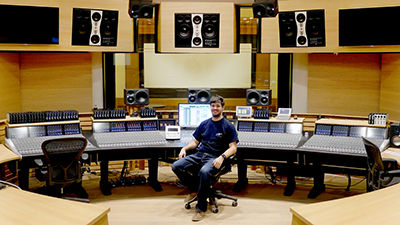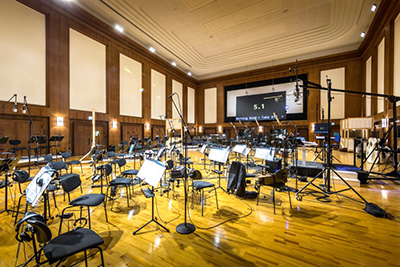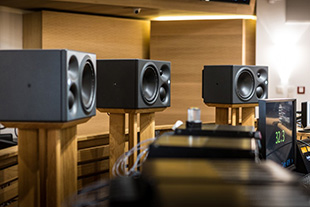![]() Specialising in sample library recording and the development of virtual instruments, Vienna Symphonic Library has opened the main rooms in a new large-scale, high-end scoring stage and studio complex, Synchron Stage Vienna.
Specialising in sample library recording and the development of virtual instruments, Vienna Symphonic Library has opened the main rooms in a new large-scale, high-end scoring stage and studio complex, Synchron Stage Vienna.
Two SSL Duality δelta analogue consoles, an L500 Live console, and a high-capacity Dante Network via SSL Alpha-Link MX converters and SSL Network I/O products, form the technical backbone of the studio.
Located in the West of the Austrian capital, the complex features acoustic and architectural design by WSDG, an extensive analogue and digital infrastructure from Solid State Logic, an extensive collection of Sennheiser and Neumann microphonesand system consultation and equipment supply by TSAMM Professional Audio Solutions.
 Vienna Symphonic Library CEO and founder Herb Tucmandl had been planning a hybrid studio for some years – one that would provide uncompromising orchestral recording facilities yet was flexible enough to accommodate all modern production approaches. He eventually purchased an original 1940s stage (the former Film City Vienna) that had been neglected for some time. Local regeneration had seen the demolition of many buildings of similar age in the same area, though this building had been saved by a preservation order on a rare cinema organ housed in the central live space. ‘We could not have built a building this size from scratch,’ he recalls. ‘We were lucky that it became available at the same time we were looking.’
Vienna Symphonic Library CEO and founder Herb Tucmandl had been planning a hybrid studio for some years – one that would provide uncompromising orchestral recording facilities yet was flexible enough to accommodate all modern production approaches. He eventually purchased an original 1940s stage (the former Film City Vienna) that had been neglected for some time. Local regeneration had seen the demolition of many buildings of similar age in the same area, though this building had been saved by a preservation order on a rare cinema organ housed in the central live space. ‘We could not have built a building this size from scratch,’ he recalls. ‘We were lucky that it became available at the same time we were looking.’
The new studio features a substantial, original, room-in-room construction with up to a three meter gap around the central 540m2 Stage A. ‘It sounds really open,’ says Technical Director & Chief Audio Engineer, Bernd Mazagg. ‘I think it’s one of the best rooms in the world.’
Additional studio and office facilities surround that central stage, including the 80m2 ‘B’ live room, Control Rooms A and B, production lounges and facilities, and office space for the Vienna Symphonic Library staff and operations. There is also a temperature-controlled basement instrument storage area with elevator access to the main stage.
The centrepiece of Control Room A is the 96-channel SSL Duality δelta Pro Station console, while Control Room B will house a 48-channel Duality δelta. Monitoring for the musicians in Stage A is managed by an SSL L500 Live console. According to Mazagg, the Duality δelta console was their first choice for several reasons, not least being its flexible input path. This allows the operator to choose between using just the ultra-clean Super Analogue path or adding the VHD (Variable Harmonic Drive) circuit for an adjustable, characterful input.
The Duality Pro Station ‘wrap-around’ frame allows the centre section to accommodate a large display so that the operator can have direct DAW control from the sweet spot, while keeping the rest of the console within easy reach and taking advantage of the Duality’s DAW control aspect. Dualities were chosen for both the A and B control rooms so that clients can easily move between the two spaces, depending on need. This also allows both consoles to be used simultaneously, effectively creating a single 144-channel recording console.
In addition to analogue wiring between the control rooms and recording spaces, audio is converted and distributed via a high-capacity, redundant Dante network to all spaces and rooms in the facility for recording and monitoring. SSL Alpha-Link MX 16-4 and 4-16 interfaces do the A/D and D/A conversion, while Madi-Dante bridging and sample-rate conversion is handled by SSL Network I/O Madi-Bridges. Pro Tools HD I/O, meanwhile, is taken care of by SSL Delta-Link interfaces.
The Network is clocked at the recording sample rate (normally 192kHz) and, by dividing this word clock and using the fast, high-quality sample rate conversion in the Network I/O Bridges, other components in the system can be clocked for appropriate sample rates. Pre-lay sessions can be played back at 48kHz, for example, while the monitoring feeds and the L500 console can be clocked at 96kHz. The network latency is less than 0.7ms from microphone back to headphones – something that Mazagg notes was only possible using the SSL Network I/O and Alpha-Link combination together with careful network design.
Mario Reithofer of TSAMM Professional Audio Solutions helped specify much of the technology in Synchron Stage Vienna, and supplied not only all of the SSL products, but most of the other equipment as well. He was instrumental in specifying the Dante infrastructure: ‘First we came up with a Madi solution, but it was too complicated,’ he explains. ‘Dante has given them fantastic flexibility and redundancy in a simple network.’
For monitoring, the small footprint, high channel count, and flexible structure of the L500 made it an ideal choice for this role. Monitoring inputs are picked straight from the Dante network and mixed on the L500 to a large number of monitor outputs – sometimes more than 20 for large orchestral sessions. ‘The Query function makes it really easy to handle those mixes,’ says Mazagg. ‘You can simply select the monitor path you want to mix into and you have everything at your fingertips.’
Initial recording tests at the facility were undertaken with full orchestra, and attended by a number of influential film music personalities, including conductor and orchestrator Conrad Pope, and music scoring mixer Dennis Sands. The Duality preamps were preferred for most inputs, with the console’s VHD circuit used to add colour to certain inputs. ‘For me it was quite amazing to hear the complete studio for the first time,’ says Mazagg. ‘I was nervous. I knew that it could sound really good, but when I heard the Orchestra playing through the speakers, and though the whole signal path for the first time it was simply amazing – much better than we’d hoped it could be.’
Synchron Stage mics
 In keeping with the studio’s aims, its microphones have been selected with considerable care: ‘Our selection of microphones is generally very modern,’ explains Mazagg says. ‘In addition to the provision of good sound, an important criterion for all new acquisitions is reliability – if you have 80 musicians in the recording studio and are subject to time and cost pressures, you must be able to rely on the microphones.’
In keeping with the studio’s aims, its microphones have been selected with considerable care: ‘Our selection of microphones is generally very modern,’ explains Mazagg says. ‘In addition to the provision of good sound, an important criterion for all new acquisitions is reliability – if you have 80 musicians in the recording studio and are subject to time and cost pressures, you must be able to rely on the microphones.’
Synchron Stage Vienna has three Neumann M 150 Tubes, which are regularly used for orchestral recording in a Decca Tree configuration. The facility’s two M 149 Tubes provide nine directional response patterns and a seven-level subsonic filter. The dual membrane microphones are generally used on double basses. ‘If there are a lot of instruments, the cardioid has proven itself as a directional response pattern that minimises disturbing crosstalk,’ Mazagg explains.
The mic complement also includes three Neumann KM 133 A models: ‘If someone wants to use a very modern Decca Tree, these condenser microphones are the tools of choice,’ Mazagg explains. ‘Personally, I like using the KM 133 A as a surround microphone in a set-up in which there are three M 150 Tubes facing forwards and two KM 133 A microphones facing backwards. I think the KM 133 A has very good impulse response in this case – it makes the rear channels sound a bit more fresh and open.’
The standard equipment at Synchron Stage Vienna also includes eight Neumann KM 140 (KM 100 plus AK 40) and eight Neumann KM 184 pressure gradient microphones. ‘We are very happy with our analogue microphones from Sennheiser and Neumann,’ says Mazagg.
Six Neumann TLM 170 R large-diaphragm microphones are used, among other things, for recording horns. And there are eight classic Neumann U87 Ai mics: ‘You just put them there and there is no further discussion,’ Mazagg quips. While most commonly used for cellos, trombones and tubas, as an all-rounder, the studio standard U87 Ai is also very popular in other contexts.
‘Microphones from the Sennheiser MKH 8000 series are my favourites among the small-membrane microphones – I find them very impressive,’ says Mazagg of the capsules that feature a frequency response of up to 50kHz. ‘The small capsules sound particularly good with the strings. I primarily use the MKH 8040 with a cardioid pattern, and we have six of them. Depending on the context, the wide cardioid provided by the MKH 8090 is also impressive, and we also have six of them.’
The studio’s microphone pool also includes dynamic microphones from the Sennheiser line, with five MD 441-U, five e906 and three MD 421-II. These proven models are used primarily in Stage B, in which rock and pop productions can be realised completely independently of Stage A. ‘With these microphones, every user knows exactly what to expect,’ Mazagg says. These dynamic microphones are also used in orchestral productions, depending on the particular taste of the producer especially if jazzy sounds or a big band sound are required. The MD 441 models are then used to record the wind section, while the e906 microphones perform very well on percussion instruments such as congas and bongos.
 For monitoring, the 115-sq-m Control Room A at Synchron Stage Vienna has nine Neumann KH 310 A active loudspeakers with MMD waveguides and two KH 810 subwoofers. The compact studio monitors are used as an alternative to large speakers embedded in the walls and also serve as a monitoring solution for multi-channel projects, supporting both ‘traditional’ surround applications in 5.1 format and also 9.1 setups. For Mazagg, the microphones of choice in the latter context are nine Sennheiser MKH 800. He also experiments with microphone setups in which the five microphones on the lower level are supplemented by four microphones of a different type on the upper level. ‘We have an environment that sounds fantastic and in which one can concentrate on selecting the microphones that sound best without having to make up for any acoustic shortcomings of the premises,’ he says. If a drummer or bass player requires headphones, a Sennheiser HD 26 Pro is used to output the click track, which is an obligatory feature in a scoring stage. Conductors make use of a Sennheiser HD 380 Pro.
For monitoring, the 115-sq-m Control Room A at Synchron Stage Vienna has nine Neumann KH 310 A active loudspeakers with MMD waveguides and two KH 810 subwoofers. The compact studio monitors are used as an alternative to large speakers embedded in the walls and also serve as a monitoring solution for multi-channel projects, supporting both ‘traditional’ surround applications in 5.1 format and also 9.1 setups. For Mazagg, the microphones of choice in the latter context are nine Sennheiser MKH 800. He also experiments with microphone setups in which the five microphones on the lower level are supplemented by four microphones of a different type on the upper level. ‘We have an environment that sounds fantastic and in which one can concentrate on selecting the microphones that sound best without having to make up for any acoustic shortcomings of the premises,’ he says. If a drummer or bass player requires headphones, a Sennheiser HD 26 Pro is used to output the click track, which is an obligatory feature in a scoring stage. Conductors make use of a Sennheiser HD 380 Pro.
Synchron Stage Vienna is the vision of cellist/film music composer/director Herbert ‘Herb’ Tucmandl, in his capacity as Managing Director of Vienna Symphonic Library. Around €10m was invested in converting the listed Synchronhalle (Hall 6) of the former ORF Rosenhügel Studios, built in the 1940s, into a world-class recording studio. Symphonic recordings and film music are produced, as are high-quality samples of virtual instruments for the Vienna Symphonic Library, which are appreciated by audio experts around the world.
‘I think this by far the best studio I have been involved in,’ TSAMM’s Mario Reithofer reflects. ‘There’s no other place like this on the planet and I am very happy to have been a part of its creation.’
‘It’s incredible, the sound translates so well into this space;’ says Dennis Sands. ‘It’s very smooth and open and it sounds good no matter where you are. Truly a world class facility – certainly, its one of the best rooms in the world.’
More: www.sennheiser.com